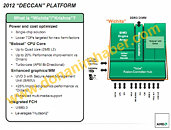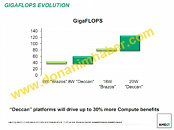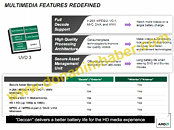Tuesday, August 16th 2011

AMD's Next-Generation Wichita and Krishna APUs Detailed
In its latest presentation to industry partners, AMD detailed its upcoming Deccan low-power computing platform, targeting the market Intel's Atom and VIA's Nano processors do. AMD is currently behind the "Zacate" and "Ontario" processors, which deliver high performance/watt x86 computing at low power draw and costs. The company's future platform will be called "Deccan," consisting of processors codenamed "Wichita" and "Krishna," targeting the ULV desktop and netbook markets, respectively. With the next generation, AMD is looking to take advantage of the 28 nanometer manufacturing process to put four x86-64 cores based on the Bobcat architecture on a single piece of silicon, with an integrated memory controller and AMD Radeon discrete-class graphics.
The biggest change here isn't the fact that there are four cores, or that it's built on 28 nm, but that Wichita and Krishna are completely single-chip. The FCH or Fusion Controller Hub has been completely fused into the APU silicon. Motherboards and notebook logic boards will have just one big chip, with no "chipset" of any form. This makes AMD's Wichita and Krishna the industry's very first true x86-based consumer SoC (system on chip). The integrated memory controller now supports DDR3-1600 MHz memory. The integrated AMD Radeon graphics is set to get a performance and SIMD boost, as well, including a Secure Asset Management Unit (SAMU). AMD's next generation APUs are slated for 2012.
Source:
DonanimHaber
The biggest change here isn't the fact that there are four cores, or that it's built on 28 nm, but that Wichita and Krishna are completely single-chip. The FCH or Fusion Controller Hub has been completely fused into the APU silicon. Motherboards and notebook logic boards will have just one big chip, with no "chipset" of any form. This makes AMD's Wichita and Krishna the industry's very first true x86-based consumer SoC (system on chip). The integrated memory controller now supports DDR3-1600 MHz memory. The integrated AMD Radeon graphics is set to get a performance and SIMD boost, as well, including a Secure Asset Management Unit (SAMU). AMD's next generation APUs are slated for 2012.




18 Comments on AMD's Next-Generation Wichita and Krishna APUs Detailed
Course, they've already lost my business outside of the used market. So, my opinion doesn't matter. That and I don't think Steve understands the meaning of the word "budget".
krishna?
haare raama haare raama, raama raama haare haare
haare krishna haare krishna, krishna krishna haare haare
\m/ there must be an indian at AMDs naming dept :D
I was planning on building an e350 based htpc in the near future, but hearing about these made me wonder if I should wait. But "sometime in 2012" might just be alittle too far off. The real question though is, what will Intel's answer to this be? Sandy/Ivy Bridge based Atoms? I just wonder how much longer Intel can keep it's market share in this segment without greatly improving its video capabilities. I am impressed with what AMD is rolling out lately, but they really need to make more of an effort in marketing. If more computer illiterates or "non enthusiast" buyers knew about AMD and APUs, they would gain a lot more market share. Most people I talk to about them didn't even know they existed.
So if they can fuse all this together then AMD should be able to make some serious cpu's in the near future for Desktops ?
Maybe a fused 24core desktop cpu eventually that is already 5 years late.
I can see a few of these APU's in a server farm / data centre, space, size, heat, power ....
NC37 APU in a macbook air sure, not in a ?? pro or whatever it is called now, not with the 2nd Gen I7 mobile cpu's they have now.
As for craphics "Apple Achilles heal" there is no chance in hell that it would improve.
I have been asking since PB G4 ATI1600 the last Apple laptop that was build.
Remember the Apple joke " my mobile phone has a better graphics card than the PB pro"
so i guess they'll tell us how many gpu cores later?
Problem is Atom doesn't scale so well once you increase the power package(it lacks out-of-order execution and has a very long pipe-line kinda like P4), so increasing frequency and TDP to compete with Brazos doesn't make sence. So Intel will leave the >8W space for ULVs and the <8W space for Atoms. At least this is what happened with the core solos and core duos before Atom was released...I don't think anyone can answer your question for certain. So my guess is as good as anybody's right now :p